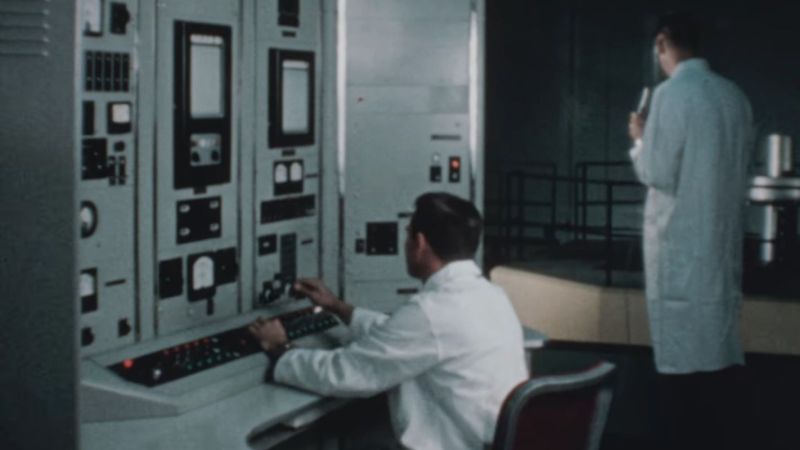The late 1950s were such an optimistic time in America. World War II had been over for less than a decade, the economy boomed thanks to pent-up demand after years of privation, and everyone was having babies — so many babies. The sky was the limit, especially with new technologies that promised a future filled with miracles, including abundant nuclear power that would be “too cheap to meter.”
It didn’t quite turn out that way, of course, but the whole “Atoms for Peace” thing did provide the foundation for a lot of innovations that we still benefit from to this day. This 1958 film on “The Armour Research Reactor” details the construction and operation of the world’s first privately owned research reactor. Built at the Illinois Institute of Technology by Atomics International, the reactor was a 50,000-watt aqueous-homogenous design using a solution of uranyl sulfate in distilled water as its fuel. The core is tiny, about a foot in diameter, and assembled by hand right in front of the camera. The stainless steel sphere is filled with 90 feet (27 meters) of stainless tubing to circulate cooling water through the core. Machined graphite reflector blocks surrounded the core and its fuel overflow tank (!) before the reactor was installed in “biological shielding” made from super-dense iron ore concrete with walls 5 feet (1.5 m) thick — just a few of the many advanced safety precautions taken “to ensure completely safe operation in densely populated areas.”
While the reactor design is interesting enough, the control panels and instrumentation are what really caught our eye. The Fallout vibe is strong, including the fact that the controls are all right in the room with the reactor. This allows technicians equipped with their Cutie Pie meters to insert samples into irradiation tubes, some of which penetrate directly into the heart of the core, where neutron flux is highest. Experiments included the creation of radioactive organic compounds for polymer research, radiation hardening of those new-fangled transistors, and manufacturing radionuclides for the diagnosis and treatment of diseases.
This mid-century technological gem might look a little sketchy to modern eyes, but the Armour Research Reactor had a long career. It was in operation until 1967 and decommissioned in 1972, and similar reactors were installed in universities and private facilities all over the world. Most of them are gone now, though, with only five aqueous-homogenous reactors left operating today.
















if I’m not mistaken, properly reconstructing this reactor was part of the entrance exam for vault tech University wasn’t it? :-)
“homogenous” is my favourite typo, when people usually mean “homogeneous”.
The definitions seem suspiciously similar, like cognates spelled differently on either side of the pond. Another meaning is antiquated but still sounds (very nearly) synonymous
It’s also interesting to note that the heating fuel used in many American homes was coal. It’s hard for us to imagine these days that you actually had to go down and shovel something that was delivered via a filthy chute into your basement into a furnace by hand. It also did not exactly produce the cleanest heat, and there was often a veneer of coal dust on everything. My grandmother told me the happiest day in her life was when they converted their home to natural gas in the early 1970s. Their electricity oddly csme from a nuclear plant.
There was also this contemporary reactor, which subsequently had many serious accidents.
https://en.wikipedia.org/wiki/Santa_Susana_Field_Laboratory
Oh my god. Rocket fuel and nuclear waste. Shooting at barrels of radioactive sodium with a shotgun “dispose” of them.
In the end, running a handful of test reactors at the site sounds like the safest thing they did.
“The late 1950s were such an optimistic time in America. World War II had been over for less than a decade”
Ooooh, super embarrassing and right out of the gate too. That’s gotta hurt and it’s gonna cost him with the judges. Perhaps the new math was too late. Alexa, ask Suri when ChatGPT would say WWII ended.
Considering that this is practically the only part of history that anybody in this country knows these days, I suspect they know perfectly well and were going off the number “1950,” forgetting the “late” in front of it
So knowing history by not knowing it. Gotcha. The dogwalker’s friend, the no-plastic-bag.
Nope, 100% correct. It HAD been over for less than a decade. Later it was over for more than a decade.
“The licensing agreement highlights a long-standing relationship between Intel and Sandia in the development of advanced technologies. Intel provided similar rights to Sandia in the 1980s for the Intel 8085 and 8051 microcontrollers. ”
https://www.sandia.gov/media/rhp.htm
Sandia hardware crm designers in the 1980s were required to retrieve their radiation experiments.
We could identify them by their radiation exposure badges.
Embedded controller forth for the 8051 family is software part of Sandia Labs 8051 rad hard project.